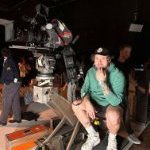-
Posts
632 -
Joined
-
Last visited
Profile Information
-
Occupation
Cinematographer
-
Location
Shoot film! facebook.com/UltraPan8WidescreenFilm
Recent Profile Visitors
-
Found Matt McWilliams, i.e. https://sixteenmillimeter.com/projects/mcopy/
-
Robert, Does Matt McWilliams have contact info or a web site?
-
Nicholas Kovats started following A New Crystal Sync Motor for the Arri 16s and JK Optical Printer K-103
-
Hi Aaron, You could also post this on, i.e. 1. Frameworks list 2. Facebook Groups such as Bolex, Super 8, Filmmakers who shoot 8mm and 16mm, etc. Best of luck! Nick K. Toronto
-

A New Crystal Sync Motor for the Arri 16s
Nicholas Kovats replied to Kamran Pakseresht's topic in 16mm
Congratulations! Fantastic work! Precision well done! -
Fantastic! Thanks for posting this latest 35mm high speed uberness,
-
Nicholas Kovats started following FINALLY - Kodak Super 8 camera! , Documentary Film Shot Entirely on Super 8 , New book: The Single-8 Story and 1 other
-
Thank you, Erik for taking the time to share your onsite experiences from such a fascinating period. Vivre la intermittent film transport!
-
Congratulations on your life's work. It is well done and has the requisite Super 8 charm and feel. Bravo.
-
No articles on the magnificent ZC1000?
-
NASA utilized upwards of 50 x high speed 16mm, 35mm, 65mm and 70mm cameras surrounding the gantry. All pin-registered. Some cameras such as the Photo-Sonics Actionmaster 500 16mm HS camera had simple "metadata" exposed to the right of the frame, e.g. time in seconds, date, camera #, etc. They had upwards of 10x huge Photo-Sonics 70mm-10A high speed cameras. Most of the cameras were predominately Photo-Sonics. Some encased at the base with quartz portals. I have two of the Photo-Sonics Actionmaster 500 16mm HS cameras with one utilized by NFL films. I had both converted to 3 or 4 pin XLR power connectors utilized with 8x cell LiPO 29.6V. It can peak at 11 to 15 amps on startup. One was converted to a PL mount. Uses 2-perf 16mm film stock with twin registration pin and pulldown. Exceedingly sharp frame line. This was a quick registration test shot at 24fps with E100D, i.e. https://vimeo.com/manage/videos/612179757 This was a quick document of UK filmmaker Cherry Kino testing our initial "prototype" with the camera tied to a huge power source consisting of batteries and huge ceramic capacitors in a milk crate. Fun times. https://vimeo.com/manage/videos/222611616 My original intent was too utilize them predominately as rock steady MOS 24fps in conjunction with the internal digital crystal sync (PLL). Amazing tech circa 1969 - 1971 regarding this PAM 500 16mm. Multiple Photo-Sonic 16mm and 35mm camera shutters can be synced which David Fincher utilized to great effect in The Fight Club (35mm). Nolan utilized Photo-Sonics 35mm cams at their maximum 360fps in Inception. Photo-Sonics even built a very rare 1000 fps 16mm camera with 8 rego pin/pulldown transport. The president of the company admitted to an fps war with either Locam or Redlake. These cameras are incredible "intermittent" transport systems not the faster but lower resolution prism transport systems which utilized frame blending. Intermittent is king for maximum frame sharpness.
-
There is not much left from the original design including the pin registered transport. Apparently standard rinky dink pulldown claw. Would be interesting who actually manufactures the camera. Did they upgrade the sd video processor to actual 1080p output? Or are they upscaling the original 480p SD spec? Will it use the same audio file system as the Logmar? Many questions. It would be beneficial if 3rd parties improved the crappy plastic S8 "co-axial" cartridge. With a darkroom loader in conjunction with a new machined or carbon fiber cartridge. I suspect the social media "influencers" will drive a hefty percentage of the initial modest run. This could get weird regarding eco-system and accessories. Think pink Barbie collectors edition. Or maybe not. I can see Nolan and Spielberg buying one in support of the effort. But not Deakin. It may trigger cheap Eastern copies with the associated cheaper labour and associated massive supply chain. Maybe not. This is a fun and wacky world whereby proud owners of $25 dollar crappy Super 8 cameras straddle one side and the digital boxes with 500 lbs of attached accessories crowd on the other.
-

Just a weird idea: Ultra 8mm
Nicholas Kovats replied to Christian Schonberger's topic in General Discussion
Did you read the preceding posts? I and others go into great detail with scanned examples regarding the current Bolex UltraPan8 2.8 R8 system that utilizes Regular 8 film stock.- 23 replies
-
- Super8mm
- widescreen
-
(and 1 more)
Tagged with:
-
I was about to post the same link. The Bolex went up over 6 years ago. Shot on a 100ft roll of V3 50D. Beautifully exposed considering they were drone/gimbal nerds. Ethereal how the Bolex rises into the air filming the dreamy 16mm impending storm in the desert.
-
Contact Robert Ditto at robertmdittoprofessional@gmail.com. He maybe able to assist. He has Clive Tobin's schematics.
-
I would agree with both suggestions. Originate in 16mm or shoot 8 perf VistaVision 35mm stills. Super 8 is such a tiny frame. Grain free is a rigid digital ideal. Organic chemistry wants to be grainy with character. Embrace Super 8's limitations relative to the larger film formats. Or don't. But sometimes it works when the tiny Super 8 medium embraces the subject. I shot the following with S8 V50D in mostly overhead sun. The brightest part of the day which optimizes the neg IF you seek "sharpness". At times I didn't. No supplemental lighting was used. All handheld. Carefully. Good glass. The natural wrap of the sun's parallel's rays is a godsend for the small format filmmaker. Beaulieu 6008Pro w/ Angeniuex 6-70mm. Scanned to 4k DPX (10 or 12 bit?) and uploaded as such to Vimeo. One can set the Vimeo player for 4K playback. My ex-partner (VFX pre/post manager) "adjusted" colors in Sony Vegas 13. Subtly. She actually manipulated the mathematical hex values of the color space. Delicately. It was the only time my film scan color space has been "treated" as such. The opening shot is a slow track into a 8 perf 35mm b/w negative.











